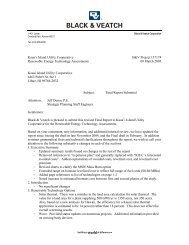KIUC Linemen All Geared Up - Kauai Island Utility Cooperative
KIUC Linemen All Geared Up - Kauai Island Utility Cooperative
KIUC Linemen All Geared Up - Kauai Island Utility Cooperative
You also want an ePaper? Increase the reach of your titles
YUMPU automatically turns print PDFs into web optimized ePapers that Google loves.
Photos courtesy of NRECA and <strong>Cooperative</strong>.com<br />
No matter where Americans choose to live<br />
today, most can get electric service—and at a<br />
price close to the cost of providing it to them.<br />
But that wasn’t always the case. Prior to 1935,<br />
life in rural America generally started at sunrise<br />
and ended at sunset.<br />
That’s because nine out of 10 rural homes had<br />
no electric service.<br />
While it was technically possible to deliver<br />
electricity to rural areas, it was not deemed<br />
necessary or economically feasible by the<br />
investorowned utilities (IOUs) of that day.<br />
The bottom line is that it was not profitable to<br />
the power companies to extend service to<br />
sparsely populated country homes.<br />
Rural residents close to a power company’s line<br />
were required to pay the full cost of connecting<br />
their homes to the system.<br />
In many cases, that fee was nearly twice the<br />
annual farm income.<br />
By Pam Blair<br />
Electrifying Rural America<br />
Once that initial investment was made, rural<br />
consumers discovered they would have to pay 10<br />
to 12 cents a kilowatthour—double the rate for<br />
urban customers. In some cases, the charge was<br />
as high as 40 cents per kWh.<br />
Given such exorbitant prices, the IOUs ensured<br />
rural America remained in the dark.<br />
President Franklin D. Roosevelt’s rural<br />
electrification program changed that,<br />
transforming the country through federal lowinterest<br />
Rural Electrification Administration (REA)<br />
loans designed to electrify all of America.<br />
But electrifying the country wasn’t easy.<br />
For years, power companies ignored all but a<br />
few heavily populated, easytoreach and<br />
economically well off rural areas.<br />
That assured them of maximizing their profits.<br />
Ironically, even with access to federal money,<br />
most IOUs still weren’t interested in extending<br />
service to rural areas.<br />
OCTOBER 2011 31
















